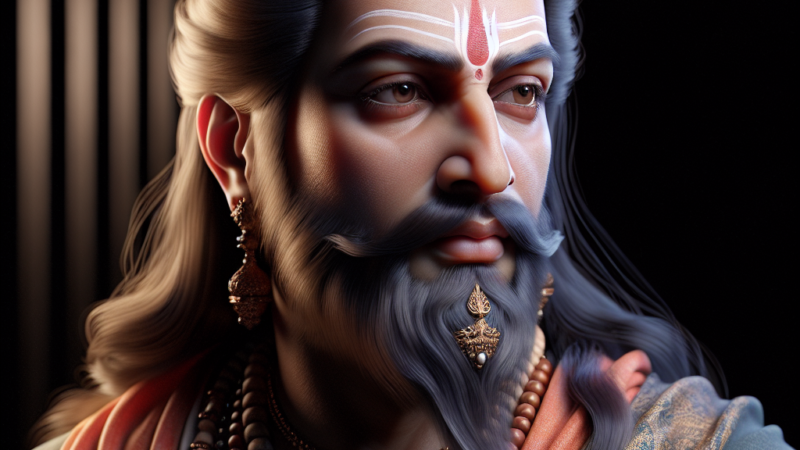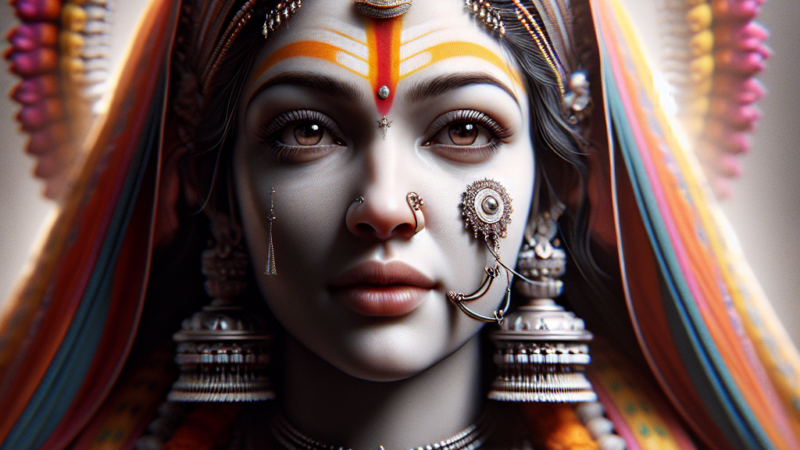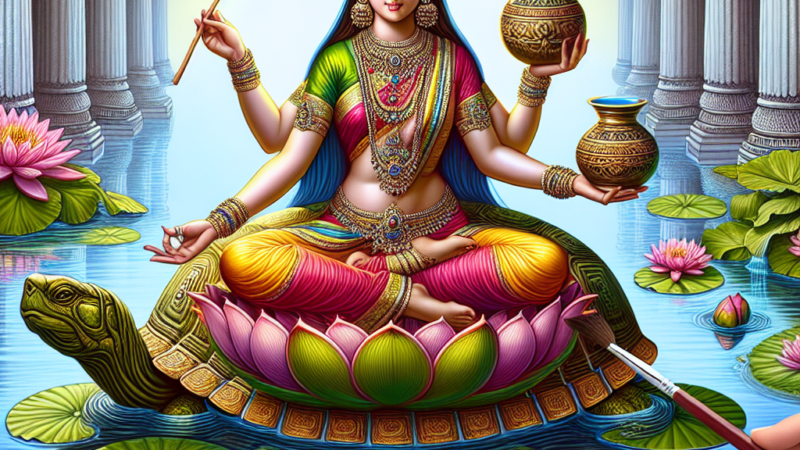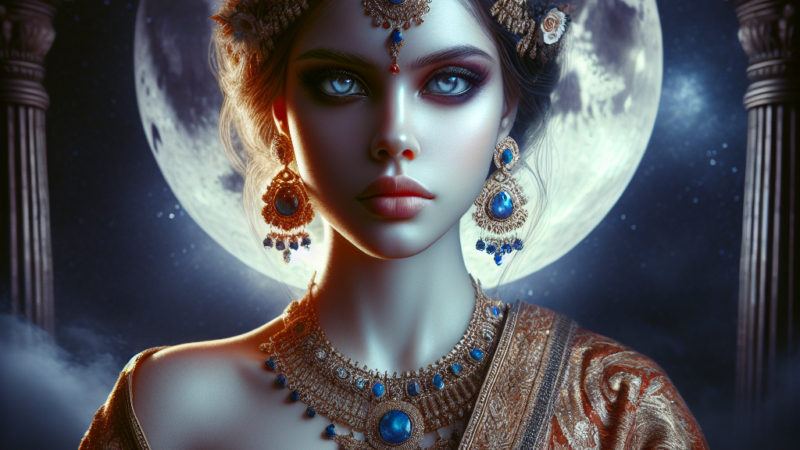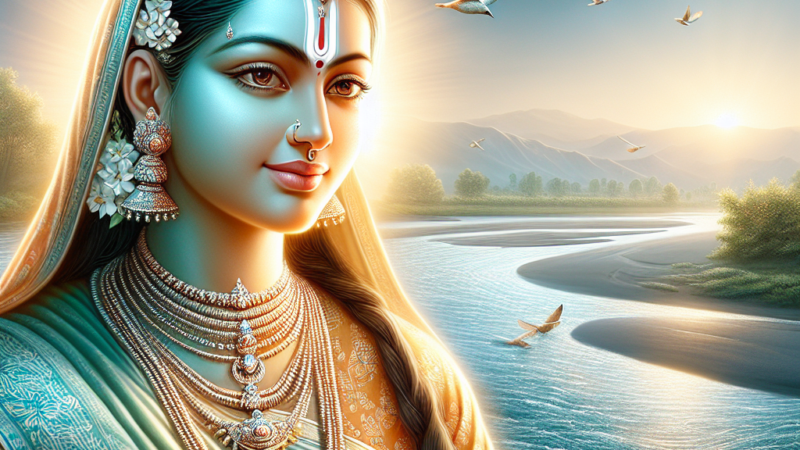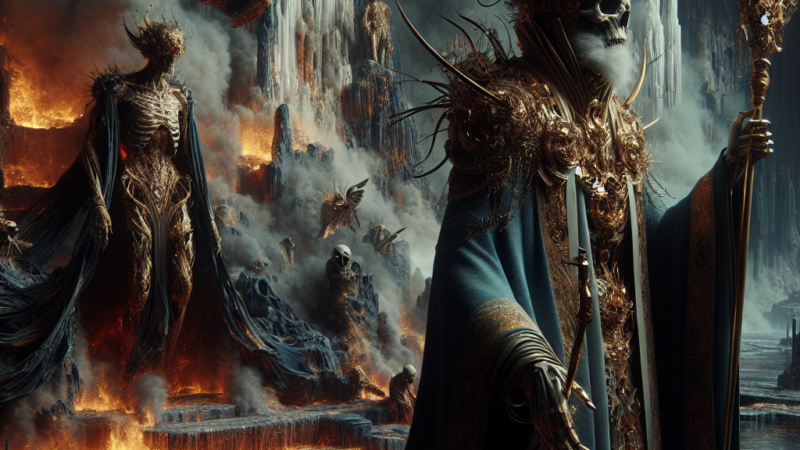Bhadrakali: The Fierce Form of the Goddess Kali
Introduction

Bhadrakali, a fierce form of the Goddess Kali, is a significant deity in Hinduism known for her powerful and protective nature. She embodies the ferocious aspect of the divine feminine, often depicted in a terrifying form to ward off evil and protect the righteous. Bhadrakali is revered across various regions of India and holds a prominent place in Hindu mythology, rituals, and cultural practices.
The importance of Bhadrakali in Hinduism cannot be overstated. She is considered a manifestation of the supreme goddess, embodying both destruction and benevolence. Her role is multifaceted, encompassing the destruction of evil, the protection of devotees, and the granting of boons. Bhadrakali’s attributes and stories highlight her as a powerful force against injustice and a compassionate mother figure to her followers.
Etymology and Meaning
Origin of the Name Bhadrakali
The name Bhadrakali is derived from two Sanskrit words: “Bhadra,” meaning auspicious or blessed, and “Kali,” which signifies the dark one or the goddess of time and change. Together, Bhadrakali represents the auspicious and protective aspect of the fierce goddess Kali.
Variations of the Name
Bhadrakali is known by various names across different regions and texts. In some parts of India, she is referred to as Mahakali, Chamunda, or Durga. Each name reflects a different aspect or story associated with the goddess, but all emphasize her power and protective nature.
Symbolic Meaning
The name Bhadrakali symbolizes the dual nature of the goddess as both a fierce warrior and a benevolent protector. “Bhadra” signifies her role in bringing auspiciousness and blessings, while “Kali” highlights her ability to destroy evil and bring about transformation. This duality is central to understanding Bhadrakali’s significance in Hinduism.
Mythological Origins and Stories
Major Myths and Stories
Bhadrakali’s mythological origins are deeply rooted in Hindu epics and Puranas. One of the most famous stories is her battle against the demon Daruka. According to the legend, Daruka had gained immense power through a boon from Lord Brahma, making him invincible to gods and men. To defeat him, the gods invoked the fierce energy of Goddess Parvati, who transformed into Bhadrakali. In a fierce battle, Bhadrakali vanquished Daruka, restoring peace and order.
Role in Major Hindu Epics
In the Mahabharata, Bhadrakali is invoked by Draupadi during her distress in the Kaurava court. Her fierce form is also mentioned in the Devi Bhagavata Purana, where she plays a crucial role in the battle against the demon Mahishasura. These stories highlight her role as a protector of the righteous and a destroyer of evil.
Other Significant Tales
Another significant tale involves Bhadrakali’s association with Lord Shiva. In some traditions, she is considered an incarnation of Parvati, Shiva’s consort, who takes on a fierce form to protect the universe. This connection underscores her role as a divine mother and a powerful warrior.
Iconography and Symbols
Depiction in Art, Statues, and Temples
Bhadrakali is often depicted with a dark complexion, multiple arms, and a fierce expression. She is adorned with garlands of skulls and carries weapons such as a trident, sword, and shield. Her iconography emphasizes her role as a warrior goddess, ready to combat evil forces.
Common Symbols
Several symbols are commonly associated with Bhadrakali:
- Trident (Trishula): Represents her power to destroy evil and ignorance.
- Skull Garland: Symbolizes the cycle of life, death, and rebirth.
- Third Eye: Signifies her ability to see beyond the physical realm and her omniscience.
- Lotus: Represents purity and spiritual enlightenment.
Meaning and Significance of Symbols
Each symbol associated with Bhadrakali carries deep spiritual significance. The trident, for example, not only represents her martial prowess but also the three aspects of time: past, present, and future. The skull garland serves as a reminder of the transient nature of life and the importance of spiritual liberation.
Worship and Rituals
Festivals Dedicated to Bhadrakali
Several festivals are dedicated to Bhadrakali, with Navaratri being one of the most prominent. During this nine-night festival, devotees worship various forms of the goddess, including Bhadrakali, through prayers, fasting, and rituals. Another significant festival is Kali Puja, celebrated primarily in West Bengal, where elaborate rituals and offerings are made to the goddess.
Common Rituals and Practices
Worship of Bhadrakali often involves chanting specific mantras, performing fire rituals (homas), and offering flowers, fruits, and sweets. Devotees also engage in meditation and recitation of sacred texts to seek her blessings and protection.
Sacred Texts and Mantras
Several sacred texts and mantras are associated with Bhadrakali. The Devi Mahatmya, part of the Markandeya Purana, is a key scripture that narrates her exploits and praises her power. The Kali Sahasranama, a hymn listing a thousand names of Kali, is also recited by devotees. The mantra “Om Krim Kalikayai Namah” is commonly chanted to invoke her energy and blessings.
Temples and Sacred Sites
Major Temples in India and Around the World
Several temples are dedicated to Bhadrakali, each with its unique significance. Some of the most notable ones include:
- Bhadrakali Temple, Warangal: Located in Telangana, this ancient temple is a major pilgrimage site.
- Bhadrakali Amman Temple, Tamil Nadu: Known for its grand celebrations during Navaratri.
- Kalighat Temple, Kolkata: One of the 51 Shakti Peethas, where the toes of Goddess Sati are believed to have fallen.
Significance of These Temples
These temples are not only places of worship but also centers of cultural and social activities. They host annual festivals, attract thousands of devotees, and serve as important landmarks in the spiritual landscape of India.
Annual Pilgrimages and Religious Events
Annual pilgrimages to Bhadrakali temples are common, especially during major festivals like Navaratri and Kali Puja. Devotees undertake these journeys to seek blessings, fulfill vows, and participate in communal worship and celebrations.
Regional Variations and Cultural Impact
Regional Worship Practices
The worship of Bhadrakali varies across different regions of India. In South India, she is often worshipped as part of the broader Shakti tradition, with elaborate rituals and temple festivals. In West Bengal, Kali Puja is a major event, marked by night-long vigils, offerings, and cultural performances.
Influence in Regional Folklore and Festivals
Bhadrakali’s influence extends to regional folklore, where she is often depicted as a fierce protector of villages and communities. Local festivals, folk songs, and dances frequently celebrate her exploits and invoke her blessings for prosperity and protection.
Cultural Impact in Literature and Arts
Bhadrakali has left a significant mark on Indian literature, art, and performing arts. She is a central figure in many classical dance forms like Bharatanatyam and Kathakali, where her stories are enacted through intricate movements and expressions. In literature, she is celebrated in numerous poems, hymns, and epics that extol her virtues and power.
Related Deities and Associations
Connections with Other Deities
Bhadrakali is closely associated with other deities in the Hindu pantheon. She is often considered an aspect of Parvati, the consort of Lord Shiva. In some traditions, she is linked with Durga, another fierce form of the goddess. These connections highlight her role within the broader framework of Shakti worship.
Family Relationships
In Hindu mythology, Bhadrakali is often depicted as a daughter or manifestation of Parvati. She is also considered a sister to other fierce goddesses like Chamunda and Chandi. These familial relationships emphasize her integral role in the divine family and her interconnectedness with other deities.
Role in the Broader Hindu Pantheon
Bhadrakali’s role in the Hindu pantheon is multifaceted. She is a warrior goddess who combats evil, a protective mother who cares for her devotees, and a symbol of divine feminine power. Her presence in various myths and rituals underscores her importance in the spiritual and cultural life of Hinduism.
Modern Relevance and Popularity
Contemporary Hindu Practice
In contemporary Hindu practice, Bhadrakali continues to be a revered deity. Her temples attract large numbers of devotees, and her festivals are celebrated with great fervor. Modern worship practices often blend traditional rituals with contemporary elements, reflecting her enduring relevance.
Influence in Modern Media and Popular Culture
Bhadrakali’s influence extends to modern media and popular culture. She is a popular figure in Indian cinema, television, and literature, where her stories are retold and reimagined. Her fierce image and powerful symbolism resonate with contemporary audiences, making her a compelling figure in popular culture.
Ongoing Traditions and Devotee Communities
Several communities and traditions are particularly devoted to Bhadrakali. These include specific sects within the broader Shakti tradition, as well as local communities that have a long-standing connection with her worship. These groups continue to uphold and propagate her rituals, stories, and teachings.
Conclusion
Bhadrakali, the fierce form of the Goddess Kali, remains a powerful and revered deity in Hinduism. Her dual nature as a destroyer of evil and a benevolent protector makes her a central figure in the spiritual and cultural life of her followers. From ancient myths to modern media, Bhadrakali’s influence is pervasive and enduring. Her continued importance in Hinduism and global culture underscores her timeless significance as a symbol of divine feminine power and protection.
Frequently Asked Questions (FAQs)
Who is Bhadrakali?
Bhadrakali is a fierce form of the Goddess Kali, known for her protective and destructive attributes. She is revered in Hinduism as a powerful warrior goddess who combats evil and protects her devotees.
What is the significance of Bhadrakali’s name?
The name Bhadrakali combines “Bhadra,” meaning auspicious or blessed, and “Kali,” signifying the dark one or the goddess of time and change. Together, the name represents her dual nature as both a fierce warrior and a benevolent protector.
What are some major festivals dedicated to Bhadrakali?
Major festivals dedicated to Bhadrakali include Navaratri and Kali Puja. These festivals involve elaborate rituals, prayers, and cultural performances to honor the goddess.
Where are some major temples dedicated to Bhadrakali?
Some major temples dedicated to Bhadrakali include the Bhadrakali Temple in Warangal, the Bhadrakali Amman Temple in Tamil Nadu, and the Kalighat Temple in Kolkata.
How is Bhadrakali depicted in art and iconography?
Bhadrakali is often depicted with a dark complexion, multiple arms, and a fierce expression. She carries weapons such as a trident and sword and is adorned with garlands of skulls, symbolizing her power and protective nature.
References and Further Reading
Devi Mahatmya
A key scripture that narrates the exploits of various forms of the goddess, including Bhadrakali.
Kali Sahasranama
A hymn listing a thousand names of Kali, often recited by devotees to invoke her blessings.
Markandeya Purana
An ancient text that includes stories and hymns dedicated to various forms of the goddess.
Books on Hindu Mythology
Several books provide detailed accounts of Bhadrakali’s myths, rituals, and cultural significance. Notable examples include “Hindu Goddesses: Visions of the Divine Feminine in the Hindu Religious Tradition” by David Kinsley and “The Book of Kali” by Seema Mohanty.
These resources offer valuable insights into the rich and complex world of Bhadrakali, helping readers deepen their understanding of this powerful deity.
We strive to present the teachings of Ramana Maharshi and the traditions of Sanatana Dharma with respect and accuracy. Terms like "mythology" are used for ease of understanding and are not meant to diminish the significance of sacred texts.
